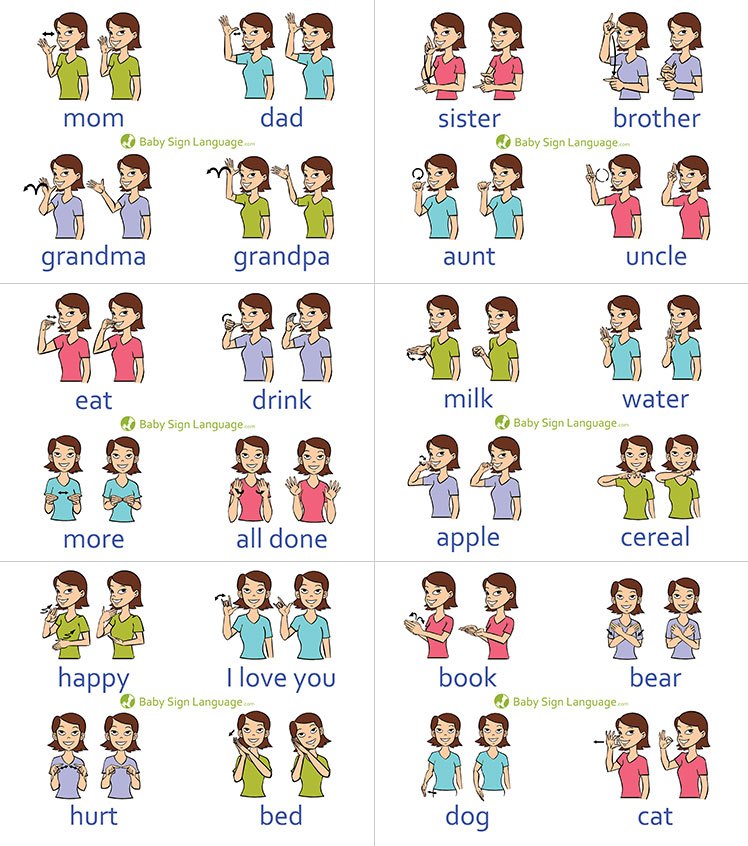Learn what your baby needs by introducing him/her to the basics of baby sign language.
Aside from learning your baby’s non-verbal cues, teaching him/her basic sign language can help you understand his/her needs better. This is particularly useful when your baby reaches about nine months to two years old. During this time, his/her vocabulary may be growing but still limited, thus sign language may aid you in understanding what he/she wants.
The Potential Benefits

Most importantly, you get to understand your baby’s thoughts and needs a little better, so that you can respond to what he/she needs quickly. Hence, your baby will have lesser tantrums, since you’d understand what he/she needs. You can start as early as four to six months old, but your baby will likely initiate signing back to you only as soon as six to 10 months onwards.
Research conducted with small studies was inconclusive to prove that babies gain any significant cognitive or language advantage over a non-signing baby. However, it may give a developing infant a way to communicate before he/she learns vocal communication. Thus, when your child is between 8 months and two years, this may help to ease frustration for both you and your child. At the very least, because of the time spent trying to teach your child baby sign language, you also pick up on your child’s nonverbal cues and gestures to understand his/her needs.
Teaching Your Baby Sign Language

Start with signs that express his/her needs. Obvious choices include being hungry, thirsty and sleepy. Although you may have chosen a particular sign to represent a need, your baby may invent his/her own sign, so do follow that when possible. Next, speak and sign at the same time to help your baby develop his/her language skills, so your baby co-relates the sign and the word you just said. Of course, repetition is key, so make sure you sign consistently and frequently.
Increase the signs’ visibility by signing close to your face. As your baby loves to look at your face and eyes, doing so helps your baby notice them better. Similarly, if you’re signing for an object, ensure you make the sign close to, or on top of the object. When your baby does sign to you, do “reward” him/her by taking immediate action, such as giving your child the milk he/she requested for promptly.
Another way to help your little one learn is to hold your baby on your lap, back to your stomach, and use his/her hands to make the signs. Do these while doing various activities, such as bathing, diapering, feeding, or reading to your little one to give them proper context.
When teaching your little one, research suggests that iconic signs (signs that represent the word, like “milk”) are more helpful for your babies. However, some non-iconic signs that also include “mummy” and “daddy” may also be fun for your child to learn. The most effective approach to communicating with your child, is to pay attention to him/her and respond to their attempts and gesturing and verbalising. Use speech and transparent gestures like pantomime and pointing to “talk” with your little one.
Resources for Baby Sign Language

Resources for learning baby sign language in Singapore include Baby Signs Singapore, which is currently offering Zoom classes ($200). Otherwise, there are books or online resources that teach baby sign language. Do note the signs may differ, so choose a language that you’re comfortable with and can remember easily. Sign language for your baby doesn’t have to be just a mother-child bonding activity – rope in your spouse, parents, in-laws or other caretakers so that they’re also familiar with such signs.
Next, take it easy and start with just a few signs, and don’t overwhelm your baby. Learning baby sign language is supposed to reduce frustration instead of adding to it. Of course, when your baby does respond and imitate your signing, it may not be perfect, so acknowledge it and respond so your baby is interested and motivated to keep signing.
Other Resources:
Baby Sign Language: Includes a comprehensive dictionary, wall chart and flash cards.
Speech and Language Kids: Free sign language flash cards for you to print out
If you prefer videos, research has indicated that whether you choose to watch these with your child, or let them watch it on their own, they will still retain some knowledge of the signs. Some of these resources include Pocket Preschool, FUNTASTIC TV – Kids Songs and Nursery Rhymes, Baby Einstein, and LiveEachDay.
12 Basic Signs

All done: Start with your upturned palms close together, then turn them over and move outwards
Daddy: Open your palm, with your fingers facing upward. Next, tap your forehead with your thumb.
Drink: Cup your hand and place it to your mouth
Eat: Tap your fingertips to your mouth with your palm down and your thumb touching your fingers.
Food: With closed fingertips, bring your hand to your mouth.
Hungry: Rub your belly
Milk: Open and close your fist as if you were milking a cow
More: Tap your fingertips together
Mummy: Open your palm, with your fingers facing upward and tap your thumb to your chin.
Potty: Put your hand in a fist and shake it from side to side.
Sleep: Extend your fingers and spread apart. Move your hand from over your face down to below your chin, with your fingers touching your thumb. Additionally, to act this out, you can relax your face and let your eyes get droopy.
Water: Put three fingers up and tap your index finger on your chin.
Relevant Reads: Newborn Care – Deciphering Your Baby’s Needs
This article was originally from Motherswork.



